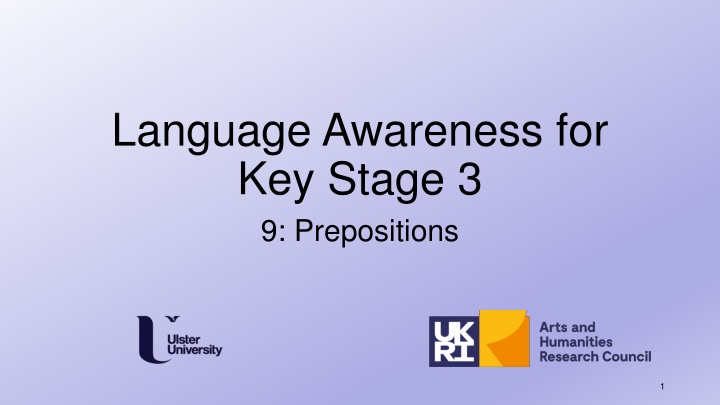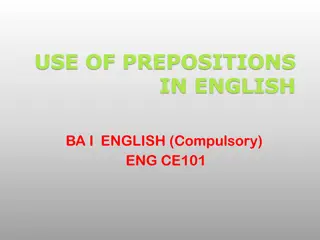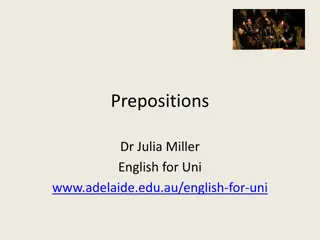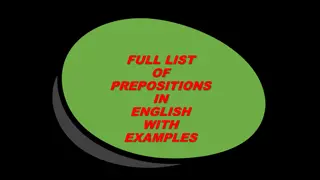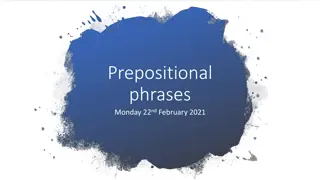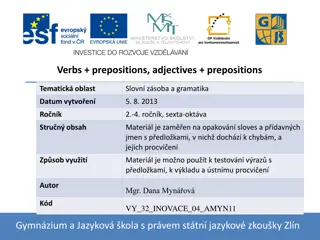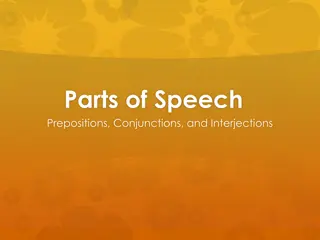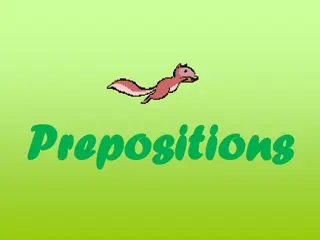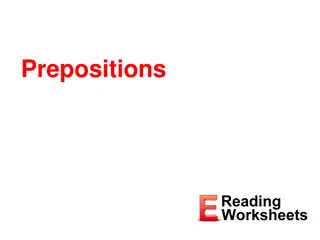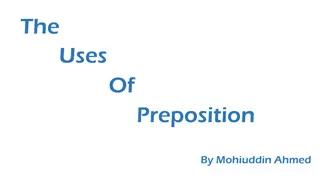Key Stage 3 Prepositions Awareness
Enhance the use of prepositions with a focus on Key Stage 3 learners. Understand how prepositions function within sentences and improve language skills through engaging exercises and examples. Strengthen your comprehension and communication abilities with this resource.
Download Presentation

Please find below an Image/Link to download the presentation.
The content on the website is provided AS IS for your information and personal use only. It may not be sold, licensed, or shared on other websites without obtaining consent from the author.If you encounter any issues during the download, it is possible that the publisher has removed the file from their server.
You are allowed to download the files provided on this website for personal or commercial use, subject to the condition that they are used lawfully. All files are the property of their respective owners.
The content on the website is provided AS IS for your information and personal use only. It may not be sold, licensed, or shared on other websites without obtaining consent from the author.
E N D
Presentation Transcript
Language Awareness for Key Stage 3 9: Prepositions 1
Roadmap Today we will take a closer look at prepositions We will see how prepositions interact with case We will also look at the different word orders that appear with prepositions We will see how some languages combine prepositions with articles Finally, we will examine how languages differ in their use of prepositions with pronouns 2
Prepositions As you may remember, prepositions are words (e.g. from, into) that express a relationship between a noun and another noun, or between a noun and a verb 1. I saw a picture of John 2. I climbed down the ladder Some words can be used either as prepositions or adverbs When they are adverbs, they are not used with a noun 3. I climbed down 3
Activity Take some time to make a list of all the English prepositions that you can find, other than the ones we ve seen (from and down) Remember, prepositions can express relationships in space or in time, as well as other kinds of relationships If there are any words that you re not sure about, then afterwards you can check them with a dictionary 4
Prepositions and Case You may remember from before that some words have special forms for different cases (e.g. I = nominative, me = accusative) As we saw, case can show whether a word is the subject or object of a verb The case of a word can also be determined by prepositions 5
Prepositions and Case You can see the relationship between case and prepositions in English 4. I talked to them 5. I talked to they Prepositions in English always need to be followed by an accusative form They can never be followed by a nominative form 6
Prepositions and Case Languages that have a greater number of cases may use different cases with different prepositions The choice of case for a given preposition is often connected to more general properties of the cases 7
Prepositions and Case For example, in German the preposition zu to takes the dative case 6. Es ist zu Staube geworden It has turned todust There is also a similar to meaning often present in the use of the dative case with verbs 7. Gib es mir! Give it (to) me! 8
Prepositions and Case Likewise, the German preposition anstatt instead of takes the genitive case 8. Sie tranken Wasser anstatt Weines They drank water instead of wine This is related to the possessive use of the genitive case 9. an meiner Statt in my stead / in my place 9
Prepositions and Case Sometimes a preposition may be used with more than one case, with a difference in meaning You can see this in these examples from Latin 10.Cucurri in hortum I ran intothe garden 11.Cucurri in horto I ran withinthe garden As you can see, example (9) expresses direction, and example (10) expresses location Accusative case Ablative case 10
Prepositions and Case English used to use cases to make the same distinction, in Anglo-Saxon times (a thousand years ago or more) 12.Ic ran in thone geard I ran intothe garden 13.Ic ran in tham gearde I ran withinthe garden Accusative case Dative case 11
Prepositions and Case English does not distinguish between the accusative and dative cases anymore One way to make the same distinctions is to use specialised prepositions (e.g. into) However, you can also use a single preposition with both meanings, and people will use other evidence to guess which is right 14. I ran in the garden I ran into/withinthe garden 12
Prepositions and Case Another possibility can be seen in the Romance languages (e.g. French, Spanish, Portuguese) As you may remember, all these languages descend from Latin However, as in English, nouns in these languages no longer have separate forms for different cases such as accusative, dative, and ablative 13
Prepositions and Case In Romance languages such as French, most prepositions can only express location, and not direction 15. Je cours dans le jardin I run withinthe garden To express direction, you need to change the verb 16. J entre dans le jardin (en courant) I enter the garden (running) Different directions need different verbs 17.Je sors du jardin (en courant) I exit the garden (running) 14
Prepositions and Word Order The languages that we have seen so far all have prepositions, which come before the noun As you may remember, some languages have postpositions, which come after the noun 18.nihon ni (Japanese) inJapan 19.T rkiye ye do ru (Turkish) towardsTurkey If you want to refer to prepositions and postpositions together, you can call them adpositions 15
Prepositions and Word Order Some languages are flexible enough that they can place prepositions either before or after the noun This was the case in Ancient Greek 20.per t n g n aroundthe world 21. t n g n p ri the world around The first order was the normal one, but the second could be used for special emphasis This sort of variation is called anastrophe 16
Prepositions and Word Order In English it is possible to put prepositions after a pronoun in questions and relative clauses 22.What was John looking for? 23.Mary found John s dog, which he was looking for This preposition stranding is not possible in most other languages As you may know, it is not normally done in more formal English 24.For what was John looking? 25.Mary found John s dog, for which he was looking 17
Prepositions and Word Order Anastrophe and preposition stranding have the same origin Remember that English and Greek are both Indo-European languages, and go back to what was once a single language There was once a time when the line between prepositions and adverbs was less distinct These words could be placed freely, like adverbs, but relate to a noun, like prepositions Different languages have reduced this flexibility in different ways (e.g. preposition stranding = English, anastrophe = Greek) 18
Activity Some of you may know other languages in addition to the ones that we ve seen Take some time and try to describe how adpositions work in these languages Are they prepositions or postpositions? Do they assign one or more cases? Is it possible to say things like I ran into the garden? Can they be moved from their usual position (e.g. anastrophe/preposition stranding)? 19
Prepositions and Articles In some languages, there are prepositions that contract with articles to form a single word 26.He spoke of the weather 27.Il parlait du temps (French) 28.Er sprach vom Wetter (German) 29.Labhair s faoin aimsir (Irish) de + le = du von + dem = vom faoi + an = faoin Prepositions Articles 20
Prepositions and Pronouns Some languages even combine prepositions with pronouns This is a common feature of Celtic languages such as Irish and Welsh 30.Labhair s f ithi (Irish) He spoke about it 31.Soniodd amdani (Welsh) faoi + = f ithi amdan + hi = amdani 21
Prepositions and Pronouns Other languages, such as French and German, do something that may seem similar 32.Cette jaquette appartient ce livre This jacket belongs to this book 33.Dieser Umschlag geh rt zu diesem Buch 34.Elle y appartient It belongs to it 35.Er geh rt dazu However, these special words, y, dazu, etc, are actually adverbs 22
Prepositions and Pronouns In French, ymeans there In German, dazu is formed from da there and zu to (like thereto in English) 23
Prepositions and Pronouns Why do these languages use adverbs instead of a preposition + pronoun? To help clarify gender In French, luican mean either him or it The same is true for ihm in German 24
Prepositions and Pronouns To avoid confusion, speakers of these languages tend to use preposition + pronoun for people and adverbs for things 36.Er geh rt zu ihm It belongs to him 37.Er geh rt dazu It belongs to it 25
Conclusion We have talked about prepositions and their similarity to adverbs We have seen that prepositions can assign one or more cases We have also seen that prepositions (adpositions) can appear before or after nouns In some languages prepositions can be put in more than one place There are languages where prepositions fuse together with articles or even pronouns Some languages substitute adverbs for preposition + pronoun combinations 26
